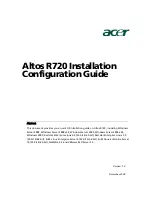
36
Chapter 3: System Administration
RAID Level
•
You can set the storage volume as JBOD, RAID 0, RAID 1, RAID 5, RAID 6, or RAID 10 (depending on
model).
Level
Model
JBOD
RAID 0
RAID 1
RAID 5
RAID 6
RAID 10
N4310
RAID configuration is usually required only when you first set up the device. A brief description of
each RAID setting follows:
RAID Levels
Level
Description
JBOD
The storage volume is a single HDD with no RAID support. JBOD requires a minimum of 1 disk.
RAID 0
Provides data striping but no redundancy. Improves performance but not data safety. RAID 0 requires a minimum of
2 disks.
RAID 1
Offers disk mirroring. Provides twice the read rate of a single disk, but same write rate. RAID 1 requires a minimum of
2 disks.
RAID 5
Data striping and stripe error correction information provided. RAID 5 requires a minimum of 3 disks. RAID 5 can sus-
tain one failed disk.
RAID 6
Two independent parity computations must be used in order to provide protection against double disk failure. Two
different algorithms are employed to achieve this purpose. RAID 6 requires a minimum of 4 disks. RAID 6 can sustain
two failed disks.
RAID 10
RAID 10 has high reliability and high performance. RAID 10 is implemented as a striped array whose segments are
RAID 1 arrays. It has the fault tolerance of RAID 1 and the performance of RAID 0. RAID 10 requires 4 disks. RAID 10
can sustain two failed disks.
Creating RAI� destroys all data in the current RAI� volume. The data will
be unrecoverable.
Edit RAID
•
On the RAID Information screen, press the Edit button to go to the RAID Information screen.
Using Edit RAID, you can select RAID ID and the Spare Disk.
















































